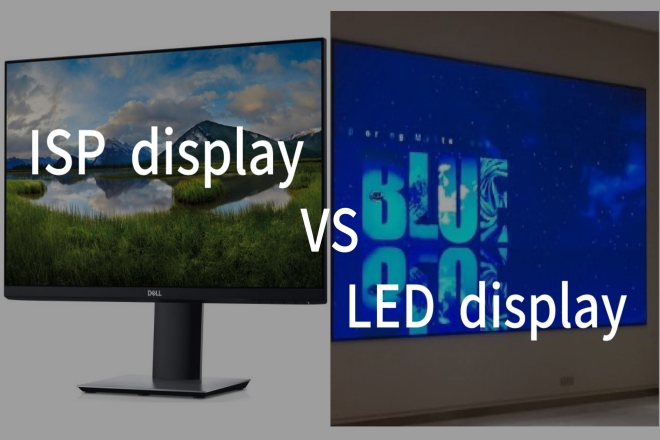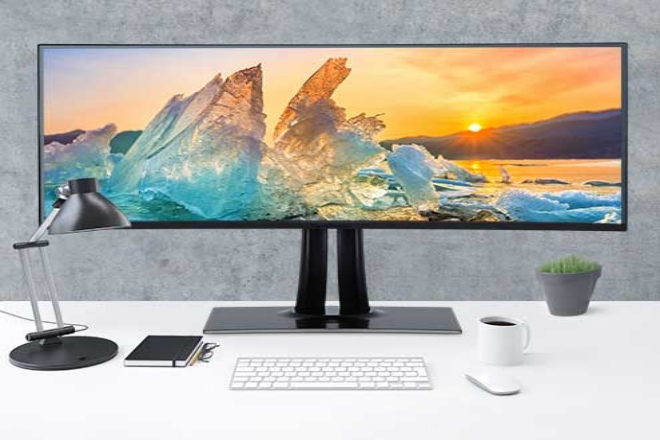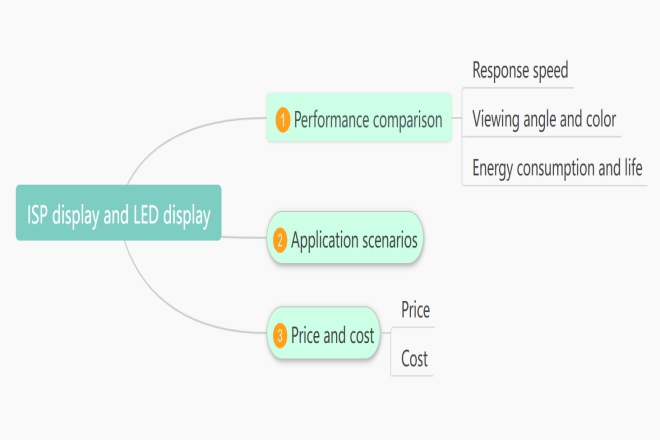Introduction

In the era of information explosion, the display is not only a window to data but also a bridge for us to perceive the world. Faced with a wide range of display technologies on the market, have you ever hesitated about how to choose?
As two popular choices, what unique charm do ISP display and LED display have? How can they meet your different needs? This article will take you directly into these two worlds and deeply analyze the core advantages, application scenarios, and selection points of ISP and LED displays so that you can grasp key information in a short time and make the most suitable choice for yourself.
Whether you are a consumer pursuing the ultimate visual experience or a merchant seeking efficient communication solutions, this article will provide you with valuable reference and inspiration.
1. Introduction to ISP display

A long time ago, people found that traditional LCD screens would change color or darken when viewed from the side, but IPS technology solved this problem.
It makes the screen basically the same color no matter from which angle it is viewed, which is very powerful. Now, many high-end computers, mobile phones, and TVs use IPS displays.
ISP display, in fact, is what people often hear called “IPS display,” which is a special LCD display technology developed by Hitachi. You can think of it as a high-end LCD screen that makes the picture look better.
1). Main features
Fast response: When playing games and watching videos, the screen switches very quickly with almost no delay.
Wide viewing angle: When watching the screen with friends, no matter where you sit, the picture you see is the same, without color difference or dimming.
Good color: The colors are very bright and natural, just like you see it with your own eyes.
Stable touch: If your phone or tablet has an IPS screen, it will feel smooth to touch without any blur or flickering.
Energy saving: Although the IPS screen has good picture quality, it is also very power-saving, so you don’t have to worry about the battery running out of power quickly.
2). Advantages and disadvantages analysis
2.1). Advantages:
Playing games and watching videos is super smooth.
When everyone watches the screen together, the picture is still beautiful.
The colors are beautiful and comfortable to look at.
It feels very smooth to the touch.
It is quite power-saving to use.
2.2). Disadvantages:
When displaying dark colors, it may be a little gray, not as dark as some technologies.
When the contrast is high, it may not be as bright as other screens.
Sometimes, the edge of the screen may leak a little light, but this situation is becoming less and less common now.
2. Introduction to LED display

LED display is a screen composed of many small, light-emitting diodes (we call it LED). These LEDs can emit light of different colors, and when combined, they can display pictures, text or videos.
Each LED is like a small light bulb, but it is more magical and can emit red, green, and blue light. By controlling the brightness of these colors, we can mix the various colors we see. There are many such LEDs on the screen, and each can be controlled independently, so it can display colorful images and videos.
1). Main features
Super bright: The LED display is very bright; even when the sun is very strong during the day, it can be seen clearly, so it is very suitable for outdoor billboards.
High clarity: There are many pixels on the screen, so the images and videos displayed are very clear, and the details can be seen clearly.
Power saving: LED display is more power-saving than traditional display because it uses less electricity, but the effect is just as good or even better.
Long life: LED lamp beads are very durable and not easy to break, so if you use an LED display, you don’t have to change the bulb frequently, saving money and worry.
2). Advantages and disadvantages analysis
2.1). Advantages:
Super bright: You can see clearly no matter day or night.
High definition: Both images and videos are super clear.
Energy saving: Energy saving and environmental protection are good for the earth.
Long life: Durable, no need to replace new ones frequently.
Wide application: Can be placed indoors or outdoors and can be used in many places.
2.2). Disadvantages:
Color may not be accurate: If the setting is not good, the color may be a little biased.
Color temperature problem: If the color temperature is not adjusted well, the image may look weird.
The price is a bit high: But in the long run, it is actually very cost-effective because of power saving and durability.
3. Comparative analysis of ISP display and LED display

1). Performance comparison
1.1). Response speed:
- ISP screen:
Usually has a faster response speed, is suitable for displaying dynamic pictures, such as games, videos, etc., can reduce the phenomenon of picture smearing, and provides a smoother visual experience.
- LED screen:
Although the LED screen has its advantages in terms of backlight technology and display effect, the response speed does not directly depend on the LED technology itself; it is related to the screen’s overall design and driving technology.
However, LED displays also perform well in refresh rate and response time, especially in high-end products, which can meet the needs of fast-changing images. However, compared with IPS in some dynamic scenes, there may be slight differences.
1.2). Viewing angle and color:
- ISP screen:
It has a wider viewing angle, usually close to 180 degrees, and can maintain good color and brightness consistency from all directions. At the same time, the color reproduction of the IPS screen is high, which can present more real and natural colors.
- LED screen:
Although LED display screens perform well in color vividness and brightness, color distortion may occur at high brightness if color management is not done properly.
In addition, the viewing angle of traditional LED displays may not be as wide as that of IPS screens, but this gap is gradually narrowing under the promotion of modern technology.
1.3). Energy consumption and life:
- LED screen:
In terms of energy consumption, LED displays have significant advantages. Due to the high efficiency of LED light sources, LED displays consume much less electricity than traditional display technologies at the same brightness.
At the same time, the long life of LED light sources can significantly reduce replacement and maintenance costs.
- ISP screen:
Although IPS screens have certain advantages in energy consumption and lifespan, they may be slightly insufficient compared to LED displays. However, with the advancement of technology, IPS screens are also constantly optimizing in terms of energy consumption and lifespan.
2). Application scenarios
- ISP screen:
Due to its true color, wide viewing angle, and fast response speed, ISP screens are very suitable for occasions with high requirements for color, viewing angle, and response time.
For example, places such as libraries, classrooms, and monitoring rooms that require long-term viewing and have high requirements for display effects.
- LED screen:
LED displays are widely used in outdoor advertising, publicity displays, large-scale event sites, etc. due to their high brightness, high contrast, and wide adaptability. LED displays can maintain clear display effects under strong light and are not affected by ambient light.
3). Price and cost
3.1). Price:
- LED screen:
Due to the complex manufacturing process of LED displays and the need for high-quality LED light sources and driving technology, its price is relatively high.
However, with the expansion of production scale and the maturity of technology, the price of LED displays is also gradually decreasing.
- ISP screen:
Compared with LED displays, the production cost of ISP screens may be slightly lower, so it may have certain advantages in price. But this also depends on the specific product specifications and quality.
3.2). Cost:
In the long run, although the initial investment of LED display screens may be high, their low power consumption and long life characteristics can significantly reduce the overall cost of use.
The long service life of LED light sources reduces the frequency of replacement and maintenance costs; at the same time, low energy consumption also reduces operating costs.
For ISP screens, although their prices may be relatively low, they may be slightly inferior to LED displays in terms of energy consumption and life.
Therefore, in the long-term use process, their overall cost may be affected to a certain extent. However, this also depends on the specific usage scenarios and needs.
Conclusion
In summary, ISP display screens and LED display screens have their own advantages, and they show unique charm and value in different application scenarios.
ISP display screens provide an ideal choice for users who pursue high-quality display effects with their excellent visual experience and stable operating performance, while LED display screens play an irreplaceable role in outdoor advertising, large-scale events, and other fields with their high brightness, high-definition, and strong environmental adaptability.
Finally, if you want to know more about LED display screens, please get in touch with us.
